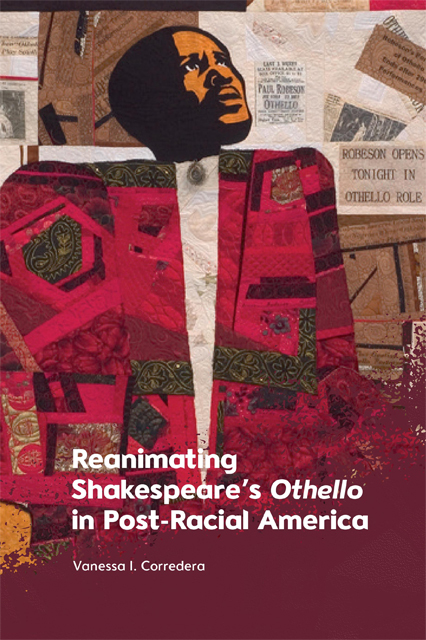Book contents
- Frontmatter
- Contents
- Acknowledgments
- Permissions
- Introduction
- 1 Images of Objectification: Othello as Prop in Kill Shakespeare
- 2 Colorblindness on the Post-Racial Stage: Hip Hop, Comedy, and Cultural Appropriation in Othello: The Remix
- 3 Othello, Race, and Serial: The Ethics of a Shakespearean Cameo
- 4 “No tools with which to hear”: Adaptive Re-Vision, Audience Education, and American Moor
- 5 At the Intersection of Gender, Race, and White Privilege: A Case of Three Desdemona Plays
- 6 Resisting Lobotomized Shakespeare: Whiteness and Universality in Key & Peele and Get Out
- Epilogue
- Bibliography
- Index
4 - “No tools with which to hear”: Adaptive Re-Vision, Audience Education, and American Moor
Published online by Cambridge University Press: 25 October 2023
- Frontmatter
- Contents
- Acknowledgments
- Permissions
- Introduction
- 1 Images of Objectification: Othello as Prop in Kill Shakespeare
- 2 Colorblindness on the Post-Racial Stage: Hip Hop, Comedy, and Cultural Appropriation in Othello: The Remix
- 3 Othello, Race, and Serial: The Ethics of a Shakespearean Cameo
- 4 “No tools with which to hear”: Adaptive Re-Vision, Audience Education, and American Moor
- 5 At the Intersection of Gender, Race, and White Privilege: A Case of Three Desdemona Plays
- 6 Resisting Lobotomized Shakespeare: Whiteness and Universality in Key & Peele and Get Out
- Epilogue
- Bibliography
- Index
Summary
Whiteness and American Theatre
It is a truth (almost) universally acknowledged: the American theatre has a whiteness problem. In his discussion of whiteness and Broadway, for example, theatre scholar Warren Hoffman posits that “with few exceptions, [the musical] is written by white people, for white people, and is about white people” (5). Writing for HowlRound about race and the American theatre, producer, writer, and director Rebecca Stevens notes that “As a field, we are still struggling with this most rudimentary of challenges—giving people of colour enough seats at the table.” And when comparing the ways that three 2019 New York City productions crafted by Black theatremakers engaged with white audiences, cultural critic Soraya Nadia McDonald places the presumption of whiteness in her title, “In theater, the white gaze takes center stage.” These observations merely scratch the surface of the multifaceted difficulties presented by whiteness in American theatre. Even so, they direct attention to how widespread these issues run: from who gets to create artistic works to who is represented on stage to the themes and ideas explored in drama to who attends the theatre and in turn how the theatre caters to them. Whiteness, it would seem, pervades American theatre.
While such claims by theatre practitioners have long been supported predominantly by anecdotal evidence, in recent years, hard data shores up assertions of theatre’s overwhelming whiteness. In 2017, Actors’ Equity released a report in which it assessed numbers taken from contracts for performances that began between January 1, 2013 and December 31, 2015. Actors’ Equity found that “nationally over the course of 2013–2015, most principal contracts went to Caucasian members, accounting for 71 percent” (8). African Americans accounted for 7.56 percent, “those who identify as Hispanic or Latino” for 2.23 percent of the contracts, and Asian Americans only 1.57 percent (12). These numbers do not tell the whole story, however, for as the report notes, “16 percent of our membership have not identified their race/ethnic background. That means, for this research, there can be anywhere up to almost 20 percent of employment in any single analysis that we cannot quantify,” a fact that gives an incomplete picture of the “problems we face.”
- Type
- Chapter
- Information
- Reanimating Shakespeare's Othello in Post-Racial America , pp. 156 - 205Publisher: Edinburgh University PressPrint publication year: 2022



